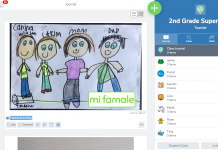
by Dan Thomas, Chris Weber, Janet Schaeffler, and Kate Ristow
All Saints Activity
Before our parish-wide Mass on the eve of All Saints, parents come to their kids’ classrooms for an All Saints activity. I’m clueless about what to do. Suggestions?
—Bill B.
Dan Thomas responds…
This is an intriguing way to do an important thing—that is, involving parents with their children in catechesis. What you do with this time can be a model for what parents and children can do together in the home. Therefore, this is a real challenge.
One of the significant things about saints is the way we as individuals and as a parish view them. Sometimes Catholics think of saints as superheroes who did great things above and beyond the call of duty. This puts saints in another world above and beyond our reach. But if we go back to St. Paul’s epistles, we realize that he calls the ordinary Christians of his communities saints (holy ones, see Romans 1:7). Thus, he sees, and we need to see also, all Christians as called to be saints. It would be valuable to make this point with the group of young learners and their parents as you begin the activity.
It is important that this activity involve parents with their children—as well as parents and children with other parents and their children—in non-threatening ways. There are numerous activities suggested by publishers’ websites and various catechist, homeschooling, and parent websites and blogs. These offer great ideas for activities. Pflaum Publishing Group has products (“A.D.: The Years of the Lord: A Timeline of Church History”; Active Learning for Catholic Kids; God’s Heroes: A Child’s Book of Saints) that could be used as resources. Loyola Press has a year-long saints calendar that could be used in the classroom to learn about the saints of a particular month.
One discussion activity that could be used would be for parents and their children to share with other parents and their children the names they were christened with or that they took at Confirmation, or the names of saints they particularly admire. Each would offer a brief explanation about why that saint is important to him or her. You could begin the session with your own sharing.
Bear this in mind: It might be a good idea to let parents know ahead of time what activity you plan for them and their children.
Dan Thomas served in catechetical leadership for over 30 years and remains involved in the National Conference for Catechetical Leadership (NCCL). He and his wife, Eileen, are the parents of two adult sons.
***
Diocesan Newspapers
I subscribe to our archdiocesan newspaper. Do you see any potential for using it as a teaching tool?
—Vicki W.
Kate Ristow responds…
The diocesan newspaper is a wonderful source for every catechist! It offers stories and information that aren’t found in secular papers, and it keeps you informed on all things Catholic. Most diocesan newsletters/newspapers feature a regular column by the local bishop or archbishop, reflections on the Sunday readings (in kid-friendly and adult versions), news from parishes across the diocese, and national and international news of interest to Catholics.
Reading the paper on a regular basis can make you aware of the many different ways parishes and Catholic groups serve others. You’ll also find photographs you won’t see elsewhere, such as a fifth-grade religious education class visiting a nursing home, Catholic school kids packing “new baby” gift boxes for pregnant teens, and a youth group washing cars to raise money for Haitian relief. Seeing the photographs and reading the stories may motivate your students to choose a service project they can implement with your help.
The diocesan newspaper may offer contests for designated groups of kids: challenging high schoolers to write essays about the Year of the Family; encouraging younger kids to create posters or slogans in support of family life; etc. Get your kids involved in the contests for which they are eligible!
Don’t discount the letters to the editor and the editorials in the diocesan newspaper. Both offer excellent opportunities for spirited discussions with older kids.
While you won’t use the diocesan newspaper every week, it is a great tool to enrich a given lesson. Catholic newspapers are easy to save because they are so compact. You can easily keep a year’s worth of issues in a banker’s box. Photos and stories can be clipped to add to a collage or mural about the Beatitudes or the Great Commandment.
Some diocesan newspapers offer a weekly kids’ puzzle page that focuses on the Sunday readings or reinforces important Catholic teachings. Permission is often given to duplicate these puzzles for students.
After you read each edition of the newspaper, stay open to the possibilities that the articles and features offer to bring our Catholic world into your classroom in new and different ways.
Kate Ristow, Contributing Editor to CATECHIST, has worked in Catholic publishing for over 30 years as a national speaker and writer, building on a wealth of experience in the religious formation of children and catechists in both parish and Catholic school programs.
***
Voting Responsibilities
A parent told me that he hoped I was teaching our junior high kids that, as Catholics, we have an obligation to vote—and to vote for any Catholic candidates on the ballot. I was blind-sided. What are our obligations regarding elections?
—Paul O.
Chris Weber responds…
Oh that it were so simple!
In its section detailing the moral life, the Catechism of the Catholic Church certainly supports the obligation to vote: “Submission to authority and co-responsibility for the common good make it morally obligatory to pay taxes, to exercise the right to vote, and to defend one’s country” (n. 2240).
However, voting is not and cannot be simply a matter of voting for the Catholic candidates. Belonging to the Catholic Church is no guarantee that a candidate will act and serve in a way consonant with the gospel! Likewise, voting according to any political ticket will not ensure that elected candidates will be good and just. To vote in good conscience, we have to dig deeper. What are the major campaign issues? How do these issues connect with the Church’s teaching? How are each of the candidates responding to those issues?
When voting for a political candidate, we must make every effort to vote for candidates who will serve in accordance with gospel values. In every diocese where I have lived, the state Catholic conferences have published voting guides that highlight candidate positions on key issues of Catholic social teaching. Anyone who has sifted through these guides finds that there is often no one candidate who approaches all issues in a way we would prefer. This can make a selection very difficult. Waiting for the “perfect” candidate will probably mean that we will never vote! Yet, vote we must. Here is where an informed conscience is critical.
In our democracy, Catholics have a responsibility to do all we can to ensure that our elected officials will serve the common good with integrity and care for others. Like all other things human, exercising our right to vote is messy, but I believe that our fully human, fully divine Savior would have it no other way!
Chris Weber has worked in the field of catechesis for over 20 years as a catechist, a parish catechetical leader, and a diocesan staff member. He is the author of Jesus-Style Recruiting: A Fresh Look at Recruiting and Forming Parish Volunteers, published by Visual Dynamics Publishing. He currently serves as Registrar at Mount St. Mary’s University in Emmitsburg, MD.
***
Mary in October
Why is October a month during which we honor Mary in a special way?
—Flannery D.
Janet Schaeffler responds…
Traditionally, the Church has dedicated each month to a special devotion (i.e., January is dedicated to the Holy Name of Jesus; March to St. Joseph; June to the Sacred Heart of Jesus). Two months are dedicated to Mary: May and October. The October dedication is because of the Feast of Our Lady of the Rosary on October 7.
This feast was first established in 1571 (called the feast of Our Lady of Victory) by Pope St. Pius V in gratitude to God for the victory of the Christian navies over the Turkish navy in the Battle of Lepanto, off the Greek coast on October 7, 1571. The Turkish forces, much larger than the Christian troops, were intent on conquering the Christian countries of Europe.
Pope St. Pius V attributed the victory to Mary’s intercession through the Rosary because in preparation for the battle, crew members on more than 200 ships prayed the Rosary. The pope also encouraged Christians throughout Europe to gather in their churches to pray the Rosary as the Christian forces faced the Turkish navy.
In 1573, Pope Gregory XIII changed the title of the day to the Feast of the Holy Rosary. In the late 1800s, Pope Leo XIII dedicated October to the Holy Rosary. In 1969, Pope Paul VI changed the name of the feast to Our Lady of the Rosary.
One of the best ways, then, to honor Mary during October is to deepen our understanding and appreciation of the Rosary. The Rosary is a prayer of meditation that helps us keep in mind some of the key events in the lives of Jesus and Mary.
There are many other Marian prayers that can be highlighted and prayed during October. They include the Hail Mary, the Memorare, the Litany of the Blessed Virgin Mary, the Angelus, the Magnificat, the Hail Holy Queen. We have a rich tradition of prayer (and Marian prayers); different types of prayer appeal to different people. What a privilege it is to share with others these many prayers that can be prayed in different ways.
After many years in parish and diocesan catechetical ministry, Janet Schaeffler, OP, is currently involved in catechetical/adult faith formation consultation, writing, workshops, days of reflection/retreats, and teaching. Her website is janetschaeffler.com.
Copyright 2014, Bayard, Inc. All rights reserved. This article is protected by United States copyright and other intellectual property laws and may not be reproduced, rewritten, distributed, redisseminated, transmitted, displayed, published or broadcast, directly or indirectly, in any medium without the prior written permission of Bayard, Inc.




